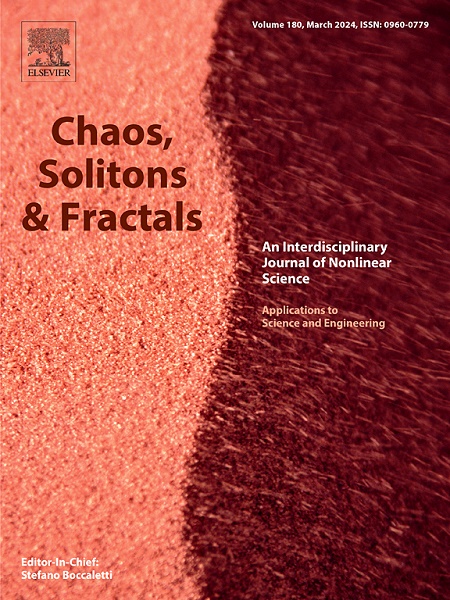Dynamics and synchronization of fractional-order Rulkov neuron coupled with discrete fracmemristor
IF 5.3
1区 数学
Q1 MATHEMATICS, INTERDISCIPLINARY APPLICATIONS
引用次数: 0
Abstract
Memristors play an important role in the modeling of neural networks as external stimuli for neuron excitation and biological synapses for information exchange. Recently, the discrete fracmemristor has shown excellent properties in describing the memory effect of nonlinear systems, including biological nervous systems. In this paper, we propose a fractional memristive Rulkov neuron model (FMRN) by introducing the fractional discrete HP-type memristor (FDM-HP) into a single fractional Rulkov neuron (FRN) as electromagnetic radiation. Their parametric modulation dynamics are investigated and compared by means of firing patterns, Lyapunov exponents, bifurcation diagrams and complexity. In addition, to verify the information transfer ability of discrete fracmemristor as a synaptic model, a fractional bi-neuron system is constructed by coupling two FRNs with FDM-HP, which is further subjected to the analyses of phase synchronization and firing behaviors. The simulation results show that the combination of FDM-HP and FRN can effectively enrich the dynamics of neuron system, achieve synchronous firing rhythms, and generate various novel firing patterns. The researches provide the theoretical and experimental supports for neuronal modeling and synapse-based synchronization, which lay the foundation for further researches on complex neural networks.
离散框架电阻器耦合分数阶Rulkov神经元的动力学与同步
忆阻器作为神经元兴奋的外部刺激和信息交换的生物突触,在神经网络建模中发挥着重要作用。近年来,离散框架电阻器在描述包括生物神经系统在内的非线性系统的记忆效应方面表现出优异的性能。本文通过将分数阶离散hp型忆阻器(FDM-HP)作为电磁辐射引入单个分数阶鲁可夫神经元(FRN)中,提出了分数阶忆阻鲁可夫神经元模型(FMRN)。通过发射模式、李雅普诺夫指数、分岔图和复杂度等方法,研究和比较了它们的参数调制动态。此外,为了验证离散框架电阻器作为突触模型的信息传递能力,将两个frn与FDM-HP耦合构建了分数双神经元系统,并对其进行了相位同步和放电行为分析。仿真结果表明,FDM-HP与FRN相结合可以有效地丰富神经元系统的动态特性,实现同步放电节律,生成多种新颖的放电模式。这些研究为神经元建模和基于突触的同步提供了理论和实验支持,为进一步研究复杂神经网络奠定了基础。
本文章由计算机程序翻译,如有差异,请以英文原文为准。
求助全文
约1分钟内获得全文
求助全文
来源期刊

Chaos Solitons & Fractals
物理-数学跨学科应用
CiteScore
13.20
自引率
10.30%
发文量
1087
审稿时长
9 months
期刊介绍:
Chaos, Solitons & Fractals strives to establish itself as a premier journal in the interdisciplinary realm of Nonlinear Science, Non-equilibrium, and Complex Phenomena. It welcomes submissions covering a broad spectrum of topics within this field, including dynamics, non-equilibrium processes in physics, chemistry, and geophysics, complex matter and networks, mathematical models, computational biology, applications to quantum and mesoscopic phenomena, fluctuations and random processes, self-organization, and social phenomena.
 求助内容:
求助内容: 应助结果提醒方式:
应助结果提醒方式:


